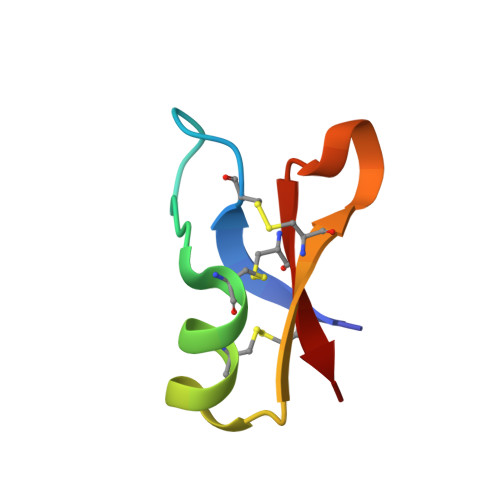Lead optimization of antifungal peptides with 3D NMR structures analysis.
Landon, C., Barbault, F., Legrain, M., Menin, L., Guenneugues, M., Schott, V., Vovelle, F., Dimarcq, J.L.(2004) Protein Sci 13: 703-713
- PubMed: 14978308
- DOI: https://doi.org/10.1110/ps.03404404
- Primary Citation of Related Structures:
1OZZ, 1P00, 1P0A - PubMed Abstract:
Antimicrobial peptides are key components of the innate immune response in most multicellular organisms. These molecules are considered as one of the most innovative class of anti-infective agents that have been discovered over the last two decades, and therefore, as a source of inspiration for novel drug design. Insect cystine-rich antimicrobial peptides with the CS alpha beta scaffold (an alpha-helix linked to a beta-sheet by two disulfide bridges) represent particularly attractive templates for the development of systemic agents owing to their remarkable resistance to protease degradation. We have selected heliomicin, a broad spectrum antifungal CS alpha beta peptide from Lepidoptera as the starting point of a lead optimization program based on phylogenic exploration and fine tuned mutagenesis. We report here the characterization, biological activity, and 3D structure of heliomicin improved analogs, namely the peptides ARD1, ETD-135, and ETD-151. The ARD1 peptide was initially purified from the immune hemolymph of the caterpillars of Archeoprepona demophoon. Although it differs from heliomicin by only two residues, it was found to be more active against the human pathogens Aspergillus fumigatus and Candida albicans. The peptides ETD-135 and ETD-151 were engineered by site-directed mutagenesis of ARD1 in either cationic or hydrophobic regions. ETD-135 and ETD-151 demonstrated an improved antifungal activity over the native peptides, heliomicin and ARD1. A comparative analysis of the 3D structure of the four molecules highlighted the direct impact of the modification of the amphipathic properties on the molecule potency. In addition, it allowed to characterize an optimal organization of cationic and hydrophobic regions to achieve best antifungal activity.
Organizational Affiliation:
Centre de Biophysique Moléculaire, Centre National de la Recherche Scientifique Unite Propre de Recherche 4301, Orléans University, rue C. Sadron, 45071 Orléans cedex2, France. landon@cnrs-orleans.fr














